Estimated reading time: 13 minutes
Most people have no idea how many uses there are for hydrogen peroxide. You probably knew that you could use it on cuts and scrapes, but did you know that these little bottles have over 50 different uses? You can replace dozens of items in your home with bottles of hydrogen peroxide.
Whether you're a prepper, a homesteader, or just someone who likes to save money, you should learn to think outside the box and find ways to use items that might seem strange to others. Most people never think to stock up on hydrogen peroxide, but it’s cheap and readily available almost anywhere.
Want to save this post for later? Click Here to Pin It On Pinterest!
1. Wound Cleaning
If you have any small wounds, cuts, or scrapes, you can use hydrogen peroxide to clean them and prevent infections. It’s a natural antiseptic solution.
2. Cure Boils
Bacteria causes boils, and they quickly become worse when left untreated. You can use 1 cup of hydrogen peroxide in a bathtub full of water to help soothe them. Lay in the tub and let the peroxide heal the boil. Soak only 30 minutes or less to avoid drying out your skin.
3. A Mouthwash Substitute
The American Dental Association tells us that hydrogen peroxide is in many commercial types of mouthwash, but those bottles can be pricey. If you can stomach the taste, use a mix of half water and half hydrogen peroxide. Then, swish it for a minute and spit it out.
4. Get Rid of Ear Wax Buildup
If you have ear wax issues, put a few drops into your ears. Wait a minute or two, then add a few drops of olive oil. Wait another minute or two, then let the fluid drain from your ears to clear out the wax.
5. Get Rid of Foot Fungus
Got foot issues? Spray a solution of half water and half hydrogen peroxide onto the skin of the affected foot each night to stop fungus growth.
6. Eliminate Mites
Most people won’t encounter mites, but you can use this to get rid of them. Your chickens might find themselves infested with mites, and a simple solution of water and hydrogen peroxide will get rid of them fast.
7. Reduces Swimmer’s Ear
Swimming can lead to swimmer's ear, which frequently causes ear infections. Try putting a few drops into your ears to prevent infections from forming after you swim.
8. Soothes Insect Bites
If you have an insect bite, try soaking a cotton ball in hydrogen peroxide and pressing it on the bite. Let it soak for a minute, then remove the cotton ball. It helps take the sting away.
9. Prevents Body Odor
Got stinky feet? Odor-causing bacteria that clings to your body are no match for the strength of hydrogen peroxide. You can soak your feet in a solution that is one part hydrogen peroxide and three parts warm water.
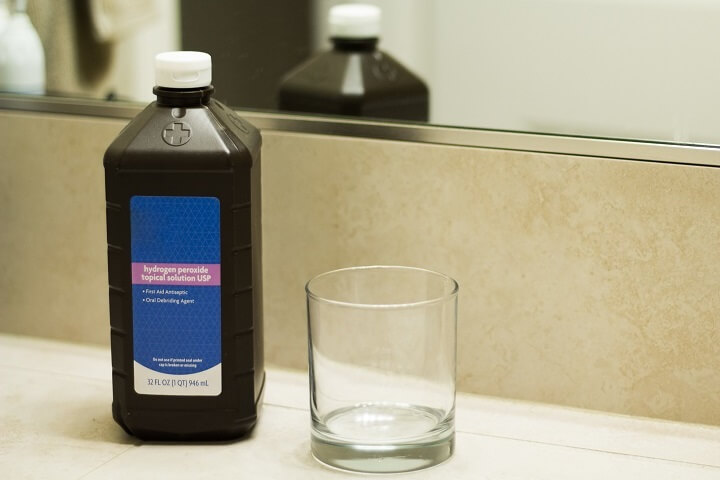
10. Treat Ear Infections
It is essential to talk to your doctor before putting anything into your ear, but many claim that using this in your ear helps to get rid of infections. Pour 3% hydrogen peroxide into a clean eye dropper and put 2-3 drops into one ear. Keep your head tilted and let it fizz for 10 minutes before allowing it to drain out.
11. Get Rid Canker Sores
Canker sores make your mouth feel horrible. Try switching some around your mouth to help treat them fast.
12. Dry Up Rashes
Hydrogen peroxide can dry out your skin, but sometimes, that’s needed for different types of rashes. If you dilute it, apply it to weepy rashes, like poison ivy.
13. Dab on Acne
No one likes to look at acne, so one thing that you can do is make a face rinse with hydrogen peroxide to kill the bacteria that lead to acne. It’s a great way to clear your complexion.
14. Ease Toothache Pain
While you do need to see a dentist for toothache pain, try swishing some around your mouth and letting it sit on your achy tooth. It should help with the pain and clear up any bacteria causing the pain.
15. Make Your Toothpaste
By adding this to your DIY toothpaste, you can help to whiten your teeth and manage any chronic stinky breath issues that you might have.
16. Whiten Your Nails
When you work with your hands, it's not uncommon for your nails to not look the best. To whiten your nails, use one part hydrogen peroxide and two parts baking soda. Mix it to form a paste and spread it over your nails. Let that sit for three minutes, then rinse away with plain water.

17. Treat Sinus Infections
Dealing with sinus infections can make you feel terrible, and if you add in being in an SHTF situation, an infection is a severe issue. Fortunately, you can make a nasal spray with hydrogen peroxide or add it to your Neti-Pot. Make sure the water you use has no chlorine in it.
18. Encourages Root Development
One of the main parts of hydrogen peroxide is the oxygen that it generates, so when you put it on your soil, it seeps down inside of the ground. That brings more oxygen to the roots, improving root development. Access to more oxygen helps roots become more vigorous and grow deeper. The healthier your roots, the stronger your plants.
19. Acts As An Insect Repellent
Pests can be a severe problem for your garden. You can use hydrogen peroxide in your garden to reduce the pest population and kill the eggs and larvae of many different insects.
20. Prevents Bacterial Rot
Bacterial infections can be a severe problem for your plants. Cuts and bruises allow bacteria to enter your plant. So, to help prevent bacterial rot, you can spray hydrogen peroxide on the wounds of branches and plants after pruning.
21. Kills Weeds in The Garden
Herbicides that you might use in your garden or yard are full of toxic chemicals that can seep into the veggies you're growing. Instead, try using hydrogen peroxide to kill the weeds in your garden. Just pour the solution directly onto the weeds, whether they're in your raised beds or stuck between the pavers of your sidewalk.
22. Quickens Seed Germination
When seeds have oxygen, they germinate faster and have a better start to a healthy future. All you need to do is mix 3% of hydrogen peroxide with one gallon of water. Then, soak the seeds in this solution. Make sure you rinse the seeds before planting. The high levels of oxygen will get your seeds started on the right foot.
23. Reduces Fungal Infections in Plants
If you’re worried about fungal infections in the garden, hydrogen peroxide fights them off. Spray some on the infected plants, and it will stop the fungus in its track.
24. Prevents Rot in Hydroponics
If you use hydroponics or aquaponics, you can use hydrogen peroxide to stop rot, which is a common issue. Since it decomposes to oxygen and water, it's much safer than other chemicals to prevent rot.
25. Disinfect Your Gardening Tools
You might not know that dirty, unsanitized gardening tools can spread fungus, bacteria, and other diseases throughout your garden. You can use a 6-9% solution to disinfect all of your tools, seed trays, pots, and containers. Another idea is to use it in a sprayer to clean the air and surfaces in your greenhouse.
26. Disinfect Growing Mediums
Soil pathogens can be a serious problem. Most potting mixes that you purchase from the store are sterilized, but if you add compost, garden soil, or sand, you might encounter pathogens.
All you need to do is mix the soil with 3-6% of the solution and cover it with plastic. Let it sit overnight, turning it once or twice.
27. Helps When Growing Mushrooms
Growing mushrooms can be a bit tricky, and sometimes you end up with unwanted molds and fungi. So, put a few drops into your fruiting chambers. It will kill mold and bacteria that could ruin your mushrooms without hurting the growing spores.
28. Purifies Water
Many preppers have no idea that hydrogen peroxide can be used to clean water! It can be used to effectively remove bacteria in the water from rivers, streams, and other water sources.
However, to do this right, you need 35% food-grade hydrogen peroxide, and you cannot get it on your skin, or it will eat away at it. You take ⅛ cup of 35% food-grade hydrogen peroxide into a gallon of unpurified water. Let it sit for 20 minutes for it to oxidize the water, and then it's ready to drink.
29. Keep Some for Bartering
Preppers always need to consider what they have available to swap at all times, and here is an inexpensive to stock for bartering. It's a tool that you might not immediately think about, but we can see how valuable it can be to have. Since the bottles are usually less than $1, keep a large stockpile!
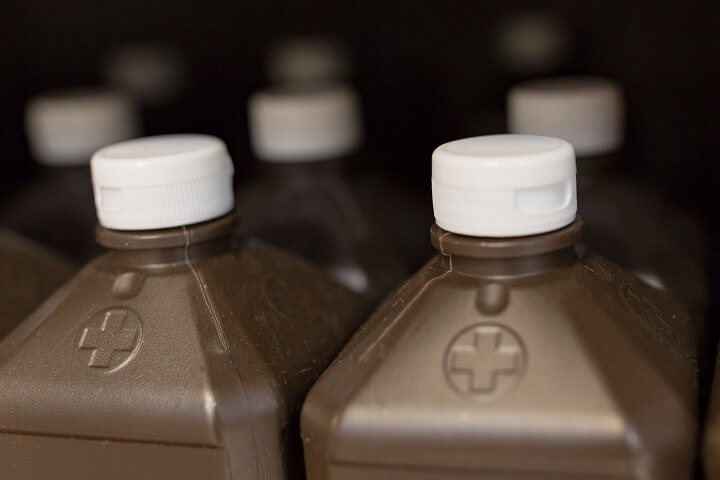
30. Cleaning The Barrel of Your Gun
Some firearm owners claim that you can clean the barrel of your gun with hydrogen peroxide. It can help remove any buildup. You can find several different solution combinations online that include hydrogen peroxide and vinegar as firearm cleaners.
31. Clean Your Kitchen Counters
Ditch the countertop cleaners you buy at the store. Just spray this on your kitchen counters to clean and disinfect them at the same time for a lot cheaper.
32. Clean Cutting Boards
Cutting boards are a breeding ground for germs and bacteria. Raw meat and other foods seep into the surface of the board. Spray it with straight hydrogen peroxide to disinfect and clean it thoroughly.
33. Disinfect Your Refrigerator
Use the same solution that you use for your countertops to clean out your refrigerator. Spray it thoroughly, let it soak for a few minutes, then wipe away with a clean cloth. This solution removes stuck-on food and disinfects.
34. Clean Your Kids’ Lunchboxes
It’s crazy how nasty a child’s lunchbox can get. Just spray some hydrogen peroxide into the lunchbox, cooler, or cooler bags. Let it sit there for a few minutes and wipe away.
35. Soak Dishrags and Sponges
Have you ever noticed how gross your dishrags and sponges could get? Try soaking them in hydrogen peroxide for 15-30 minutes to disinfect them.
36. Wash Your Veggies
The simple combination of water and hydrogen peroxide can be used as an alternative to fruit and vegetable washes. The FDA approved this mixture. All you need to do is add about a tablespoon of hydrogen peroxide into a gallon or sink full of water. Let the produce soak for a few minutes before rinsing thoroughly.
37. Whiten Loads Instead of Bleach
Don’t buy chemical bleach that is hazardous to your health. Instead, add a cup of hydrogen peroxide to your washing machine and soak all of the fabrics for 15-30 minutes. You’ll be amazed at how well it revitalizes your white clothes.
38. Fix Musty Fabric
If you have something that smells musty, try mixing with white vinegar. Then, let the fabrics soak to remove the nasty musty smell and any other unwanted odors.
39. Use It to Clean Tile
If you have tile in your bathroom, hydrogen peroxide is an excellent cleaner. Spray it directly onto the tile to remove any dirt and stains.
40. Reduces Toilet Bowl Stains
No one wants to see those yucky toilet bowl stains. Put half a cup of hydrogen peroxide into the toilet bowl and let it soak for 30 minutes. Then, scrub it to remove the stains from your toilet.
41. Clean Glass
Instead of Windex, try spraying hydrogen peroxide on your windows and mirrors. It will loosen up grime, dirt, and whatever else your kids put on the windows. Then, wipe it away with a lint-free cloth.
42. Clean Bathtubs and Soap Scum
Soap scum can be tricky to remove. One simple solution is to spray hydrogen peroxide all over your bathtub to help remove dirt, stains, and soap scum. Let it soak for 30 minutes to make cleaning it even easier.
43. Bleach Grout
If you mix it with white flour, you can create a thick paste. Then, apply it to your grout and cover it with plastic overnight. The next day, rinse with water, and your grout will be whiter!
44. Disinfect Toothbrushes and More
Need to clean your toothbrushes? Use hydrogen peroxide. Let them soak in some for a few minutes then rinse thoroughly under running water.
45. Kill Mold
Mold can be deadly if you don’t get rid of it, especially if anyone in your home has compromised immune systems. Hydrogen peroxide gets the job done fast. Just spray it directly onto the mold site and let it sit for 15 minutes. Wipe it with a clean sponge or towel.
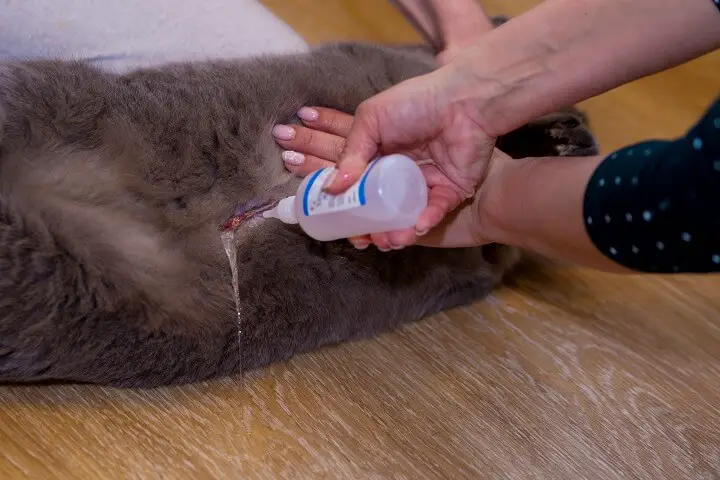
46. De-Skunk Your Pets
Did Fido come home smelling less than amazing? If a skunk sprayed your pet, mix one-quart hydrogen peroxide, ¼ cup of baking soda, one teaspoon dish soap, and two quarts warm water. Then, mix it onto your stinky animal before bathing them thoroughly.
Word of advice: don’t let it sit too long or you could bleach his fur. Oops!
47. Remove Stains in Carpet
Caret and rugs tend to be a magnet for stains. Two parts hydrogen peroxide and one part dish detergent can be applied to most organic stains such as coffee, wine, sweat, or blood. Be careful using it on darker carpets or rugs because it can bleach fabrics.
48. Neutralize Urine Smells
If urine seeped into your mattress or carpet, try spraying the area with hydrogen peroxide and letting it sit. It will soak up the smell and make everything good as new.
49. Clean Hardwood
When you have some stains or stuck-on goop on your hardwood, let hydrogen peroxide soak over it for a while. Then, scrub it with a brush. Watch it come right off!
50. Clean Your Dehumidifiers
Dehumidifiers can get grimy and gross. Try adding a pint of hydrogen peroxide to one gallon of water. Run this solution through the humidifiers to disinfect and remove any mold or mildew.
Bonus: Kill Viruses
As we explained in another article, 4 Household Products That Can Kill Any Virus, you can use hydrogen peroxide to disinfect surfaces that may have been contaminated with a virus.
Stock Up Now
It’s hard to believe that you can find so many ways to use hydrogen peroxide. Keeping plenty of bottles throughout your home keeps everything clean and makes your garden happy. All of that comes from one cheap bottle!
Like this post? Don't Forget to Pin It On Pinterest!



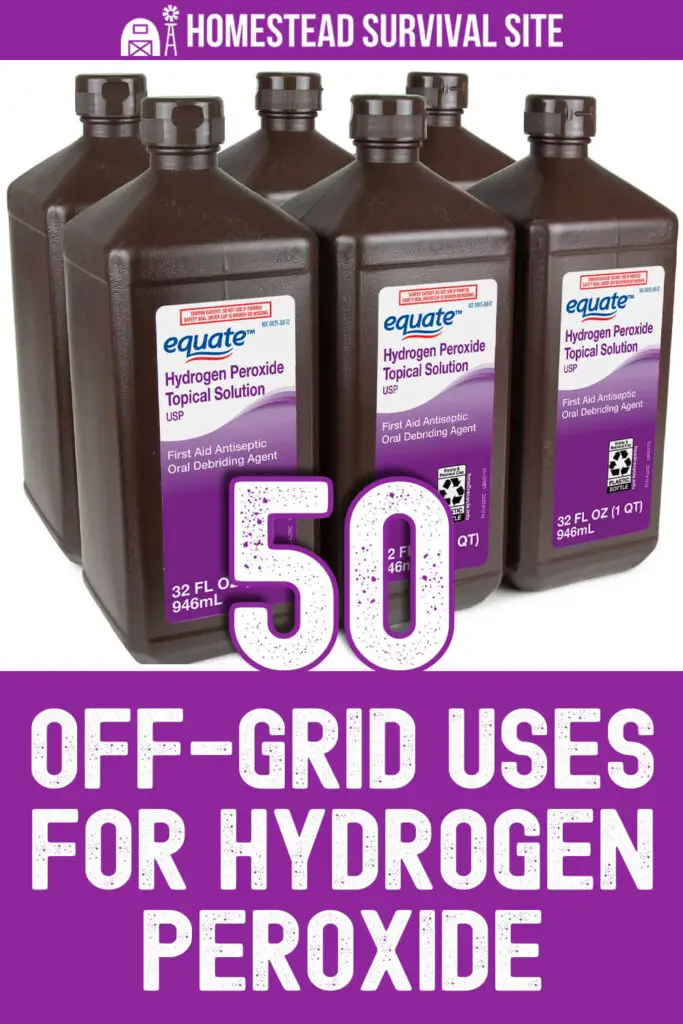


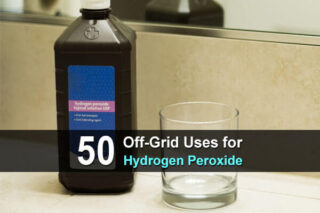





Hydrogen Peroxide, H2O2, is contraindicated for wound cleaning. It does more harm than good, unless it’s heavily diluted. Mild soap and warm water are the current First Aid Therapeutic treatments for open wounds, and has been the recommended treatment regimen for 40+ years. 3% H202 is too strong for a wound. It’s oxidation action destroys healthy tissue along with the .
Great for removing blood stains from white garments and sheets.